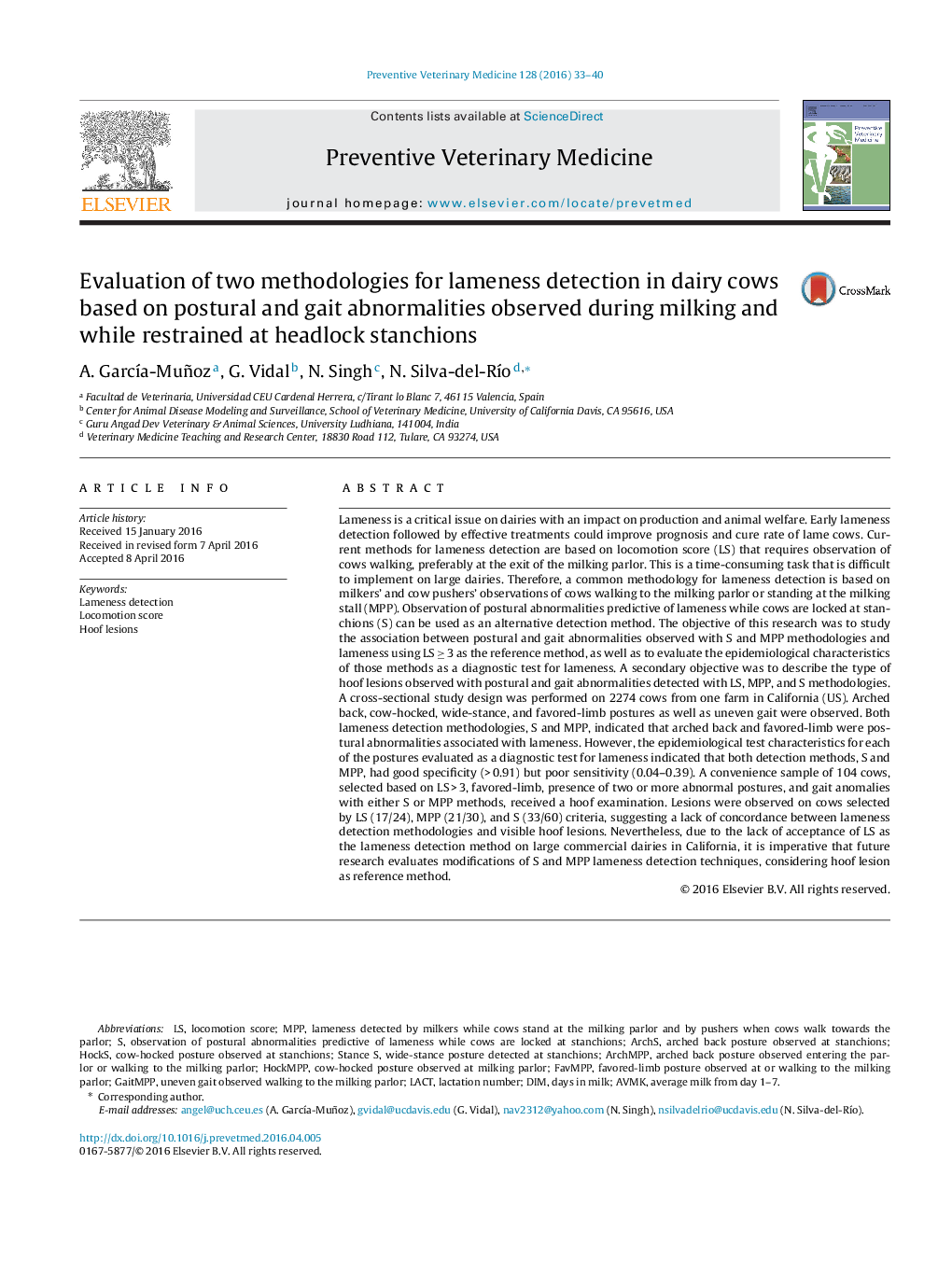| کد مقاله | کد نشریه | سال انتشار | مقاله انگلیسی | نسخه تمام متن |
|---|---|---|---|---|
| 5792929 | 1554160 | 2016 | 8 صفحه PDF | دانلود رایگان |
عنوان انگلیسی مقاله ISI
Evaluation of two methodologies for lameness detection in dairy cows based on postural and gait abnormalities observed during milking and while restrained at headlock stanchions
ترجمه فارسی عنوان
ارزیابی دو روش شناسی تشخیص لانه در گاوهای شیری مبتنی بر ناهنجاری های موضعی و راه رفتن مشاهده شده در طول شیرخواری و در حالی که در عقب مانده ها
دانلود مقاله + سفارش ترجمه
دانلود مقاله ISI انگلیسی
رایگان برای ایرانیان
کلمات کلیدی
موضوعات مرتبط
علوم زیستی و بیوفناوری
علوم کشاورزی و بیولوژیک
علوم دامی و جانورشناسی
چکیده انگلیسی
Lameness is a critical issue on dairies with an impact on production and animal welfare. Early lameness detection followed by effective treatments could improve prognosis and cure rate of lame cows. Current methods for lameness detection are based on locomotion score (LS) that requires observation of cows walking, preferably at the exit of the milking parlor. This is a time-consuming task that is difficult to implement on large dairies. Therefore, a common methodology for lameness detection is based on milkers' and cow pushers' observations of cows walking to the milking parlor or standing at the milking stall (MPP). Observation of postural abnormalities predictive of lameness while cows are locked at stanchions (S) can be used as an alternative detection method. The objective of this research was to study the association between postural and gait abnormalities observed with S and MPP methodologies and lameness using LS â¥Â 3 as the reference method, as well as to evaluate the epidemiological characteristics of those methods as a diagnostic test for lameness. A secondary objective was to describe the type of hoof lesions observed with postural and gait abnormalities detected with LS, MPP, and S methodologies. A cross-sectional study design was performed on 2274 cows from one farm in California (US). Arched back, cow-hocked, wide-stance, and favored-limb postures as well as uneven gait were observed. Both lameness detection methodologies, S and MPP, indicated that arched back and favored-limb were postural abnormalities associated with lameness. However, the epidemiological test characteristics for each of the postures evaluated as a diagnostic test for lameness indicated that both detection methods, S and MPP, had good specificity (> 0.91) but poor sensitivity (0.04-0.39). A convenience sample of 104 cows, selected based on LS > 3, favored-limb, presence of two or more abnormal postures, and gait anomalies with either S or MPP methods, received a hoof examination. Lesions were observed on cows selected by LS (17/24), MPP (21/30), and S (33/60) criteria, suggesting a lack of concordance between lameness detection methodologies and visible hoof lesions. Nevertheless, due to the lack of acceptance of LS as the lameness detection method on large commercial dairies in California, it is imperative that future research evaluates modifications of S and MPP lameness detection techniques, considering hoof lesion as reference method.
ناشر
Database: Elsevier - ScienceDirect (ساینس دایرکت)
Journal: Preventive Veterinary Medicine - Volume 128, 1 June 2016, Pages 33-40
Journal: Preventive Veterinary Medicine - Volume 128, 1 June 2016, Pages 33-40
نویسندگان
A. GarcÃa-Muñoz, G. Vidal, N. Singh, N. Silva-del-RÃo,
